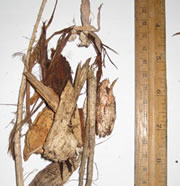Woody residues
Matching woody residues with application
The range of applications for forest biomass is large, and market demand for these applications continues to grow, both in Canada and internationally. Forest bioproducts offer Canada the opportunity to make the most of its abundant forest resources. But in order to take advantage of this opportunity, it is essential to understand which applications have the greatest potential benefit and which export markets they are best suited for.

Composite residue sample
Woody residues from both mills and the forest are a potentially large source of feedstock for the bioeconomy. As forest enterprises move away from the traditional approach of having only a few product streams and enter the new era of bio-refining with multiple product streams, such as energy, chemicals and bio-based materials, they need to understand the characteristics of the raw materials they are using. System failures and unsuccessful industry start-ups are most often a result of lack of understanding of supply and variability of available materials.
In order to determine where to situate potential biorefineries and how to best match the feedstock to conversion technologies, the feedstock must be quantified, characterized and classified.
For example, Canadian Wood Fibre Centre (CWFC) researchers and partners are currently quantifying sawmill residue, with the aim of identifying applications for it that can lead to improved economics for Canadian sawmills. Once the physical, thermal and chemical characteristics of sawmill residue are well understood, its compatibility with various conversion technologies can be matched and the supply chains established.
Similarly, CFS/CWFC researchers and partners are quantifying forest harvest residue on the basis of species composition, harvesting and storage practices. Understanding both the characteristics of the residue and the specifications of the various conversion technologies will help identify winning opportunities.

Grinding operation after biomass harvest
Researchers are also developing a forest biomass user guide for bioproduct opportunities, with the aim of describing various biorefinery streams, specifications of the technologies and optimal characteristics of the various feedstocks. Forest enterprises will then be able to match this information with their feedstock inventories to best situate new biorefineries.
As new domestic and international markets for forest biomass mature and demand increases, questions about the quality and sustainability of Canada’s supply of woody residues are being raised by both industry and an engaged public. A number of national and international initiatives aimed at developing standards, certification systems and sustainability criteria for forest biomass are currently underway and will help to ensure the success of the bioeconomy.
Canadian Forest Service key contact
Cyriac Mvolo, Research Scientist
Page details
- Date modified: